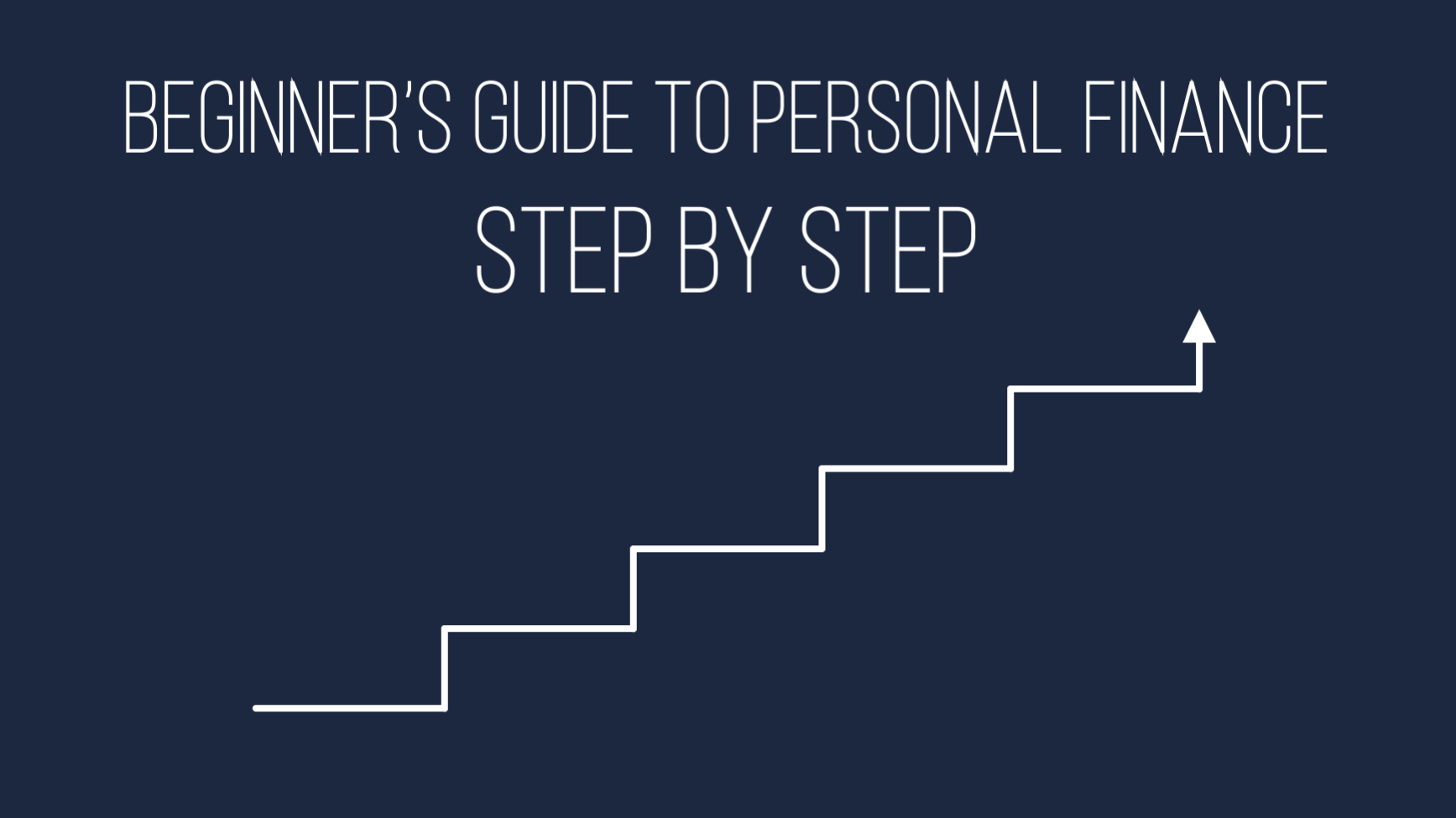Personal finance: Step by step guide for the beginner
/Many people struggle with the very first steps of setting up personal finance tools. If you have been avoiding the question, "how should I even start?" then this one's for you.
Chances are you know you should be doing more to get your finances in order, but you have no idea how. Follow this guide. But keep in mind that this is the bare minimum. I'm not asking you to become an investment guru; or to stick to ramen noodles 4 nights per week (wasn't college great?). I'm spoon-feeding you the basic steps to set yourself up for success.
Some of these steps may sound time-intensive or confusing, but I promise they are very simple and quick once you give them an honest try. If you decide to do NOTHING else on this list, at least do the first 5 steps. These 5 steps alone can help you get dramatically closer to your goals.
One last thing—before anyone gets up in arms about how basic this list is, stop for a second and realize that most people in the US do not have ANY personal finance education. So just a quick disclaimer: I am not telling you to follow this list and then you're all set! Personal finance is something you have to work at; and it is important to remember that some people are more advanced than others.
Short version for those of us with little patience
1
Pay yourself first
This is a simple technique that you can use to force yourself to hit your target savings amount.
Automatically direct a target amount into your savings account and never touch that account!
2
Set up a "high yield" savings account
Traditional bank accounts offer laughably low interest rates. Ditch those accounts!
Sign up for a "high yield" account:
Amex High Yield Savings
Discover Savings
GS Bank Savings
PurePoint Financial Savings
3
Pay off your high-interest debt
If you have high-interest debt (student loans, car financing, wedding debt, etc) then pay this off first. Think of this as a guaranteed return on investment (and you thought death and taxes were the only guarantees!).
4
Contribute to your 401k
Contribute up to the amount or percentage that your employer matches. This is free money and gives you a tax break!
5
Link all of your accounts to a dashboard
Use a dashboard to keep track of your finances and stay on top of your spending.
These are some solid free options:
Personal Capital (Get $20 for signing up!)
Mint
Clarity Money
6
Set goals and budgets
It is important to keep track of your spending in order to hit your saving goals. But it's not enough on its own. Keeping track is only effective if you have a target in mind.
Use my simple budget tool to build a budget for yourself.
7
Be honest with yourself
There is no such thing as a perfect financial plan. Everyone has different skills and goals.
Be honest with yourself and don't blindly follow the "right" path if you know deep down that you won't be able to commit to it.
Instead, plot out a path that utilizes your skills, interests, and tendencies to meet your goals.
Ok, so now you're interested? Here are the details
Pay yourself first
This is a simple technique that you can use to force yourself to hit your target savings amount.
Most large employers allow you to set up two direct deposits within their payroll system. Set up the first direct deposit to go directly into your "no-touching-allowed" account. Choose your target savings amount, and voila! You now have a system to pay yourself first.
Then set up a second direct deposit that goes directly into your checking account ("working capital"). This is your monthly allowance or spending money.
Note: If your employer only allows one direct deposit, use your bank's automated transfer tool to send your target savings into your "no-touching-allowed" account on the same day your paycheck hits your checking account.
Set up a "high yield" savings account
I have been amazed by how many people are still using a basic checking account and savings account combo.
Checking accounts generally earn 0% interest, and should only be used to pay bills ("working capital").
Traditional bank savings accounts are currently offering in the neighborhood of 0.01% interest. Let's put that into perspective: to earn a single $1 in interest over the course of a year, you would have to maintain a balance of $10,000; to earn just $10 in interest (that won't even buy you a burrito with guac in Kalamazoo, Michigan!), you would have to maintain a balance of $100,000!
Luckily, there are better places to keep your 6+ month cushion (see rules of thumb). Many online banks have started to offer so-called "high yield" savings accounts that offer >1% annual interest. I know, I know, it still doesn't sound like a lot.
But consider this: If you open an account at 1.20% (the going rate as of this writing), it would take a balance of only $83 to earn $1 of interest over the course of the year. To earn $10, you would need to maintain a balance of $833. This is over 100x better than a traditional savings account!
And if you maintain a balance of $100,000 with the "high yield" account at 1.20% you would earn $1,200, which means you can get over 100 more burritos per year (I mean, if you want)!
Pay off your high-interest debt
If you have high-interest debt (student loans, credit cards, car financing, wedding loans, etc) pay this off as soon as you can.
Student debt can put a huge strain on cash flow for recent grads and can stay with you for a long time.
And unfortunately, student debt interest rates tend to be pretty darn high. Let's take this as an example.
When I graduated from college, I was lucky enough to have a minimal amount of student loans. But the loans I did have had interest rates over 6%! If I let my cash collect in a savings account yielding 1%, I would be wasting money on interest.
I started off by paying down the monthly required amount, but as soon as I had enough money to pay them down, I did it (even though it cut a hefty chunk into my savings). Why?
By paying down my loans early, I saved myself 5% net interest (6% interest rate minus 1% yield in savings account) over the life of the loans. This was essentially a guaranteed return on investment. In this day and age, if you can get 5% guaranteed, then do it. Like right now.
Notice that the rule is to pay off your high-interest debt, not necessarily all of your debt! If you are lucky enough to have a mortgage with 3% interest, you should invest your cash elsewhere, and pay the minimum on your mortgage.
Contribute to your 401k
You should always contribute up to the amount or percentage that your employer matches. This is free money (well, eventually)! Most 401k plans have a vesting period of 3 years, which means that you will not have earned the matching amount until 3 years from the contribution date.
For example: let's say you earn $65,000 annually and your employer matches up to 4% of your total income. If you contribute exactly $2,600 (4% of total income), your employer will also contribute $2,600 over the course of the year. This matching amount will appear in your 401k account, but if you decide to leave your employer before the 3 year mark, you would give up the matching $2,600. If you wait until after the 3 year mark, you are free to leave and take your free money with you!
If you are comfortable with your financial situation and have the ability to contribute up to the annual maximum ($18,000), then do it. This hits two birds with one stone: maximizes your tax benefit and maximizes your employer's matching contribution.
This is where I go a little bit off the beaten 401k path. Unless you are absolutely certain that you will not need access to additional cash in the near term, I would recommend that you do not contribute the full $18,000 annual limit. What if your oldest kid decides to go to grad school? Or you have a mid-life crisis and decide you don't want to work for your terrible boss any longer? Having more flexibility is a priceless asset that does not have tax benefits, but can give you more peace of mind. But only do this if you can truly trust yourself to invest this money and not spend it outside of your budget. Remember to be honest with yourself (see point 7).
Link all of your accounts to a dashboard
There are many sites online that allow you to link all of your accounts onto a single dashboard tracker. This is an incredibly effective way to track your monthly cash flow.
I have used many of these programs and I find Personal Capital and Mintto be very intuitive and informative (not to mention free). You might be surprised at some of the trends you will find!
Clarity Money is a new interesting program out there that helps you keep track of bills.
Set goals and budgets
Putting all of your accounts in a single dashboard is a great start. But it is not enough on its own. In order for the dashboard to be useful, you need to have a target.
It's very common to struggle with a mental budget. But once you put your goals down on paper, the task at hand feels remarkably more manageable.
Check out my handy budget tool in excel (don't worry, it's super easy to use) that you can customize to your liking. If you have any questions or feedback on the tool, feel free to send me a message anytime!
Are you curious about how much you can afford to save each month? Would you like to know how much you can afford to pay on rent, while still saving a specified amount each month? Seriously, check out my budget tool. Why are you still reading this?
Be honest with yourself
It is very important to be honest with yourself throughout this entire process. Everyone has different skills, tendencies, and temptations.
If you know you won't be able to keep yourself from spending your savings, then maybe the right choice for you is to max out your 401k. But if you know you will put those extra savings toward smart investments, maybe the right choice for you is to give yourself some extra flexibility by not locking it up in your 401k.
Don't be too hard on yourself with your budget. The tool is meant to be a guide to make you think about which expenses to prioritize and how to afford the lifestyle you want.
At the end of the day, the goal of this site is to help you gain more freedom, independence, and flexibility. So have some fun, and don't impose restrictions that are TOO tough; you probably wouldn't be able to stick with that anyway!






















Is Lasik surgery a good investment? I have (well, I had) terrible vision. When I'm not wearing my contacts or glasses, I can't tell how many fingers you're holding up from 3 feet away. Now I can see perfectly. The outcome has been miraculous. But is it a worthwhile financial investment?